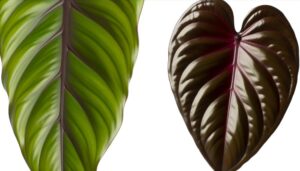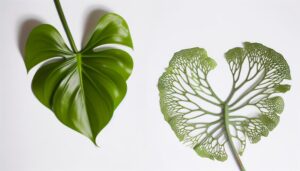Philodendron White Knight Vs Pink Princess
The Philodendron White Knight and Pink Princess are distinguished for their unique variegations and growth habits. The White Knight exhibits marbled green and white leaves with elongated internodes, requiring vertical support for its climbing nature.
In contrast, the Pink Princess features bushier growth with dark green to black leaves adorned by pink variegation and shorter internodes, needing occasional pruning for shape management. Both thrive in bright, indirect light and humid conditions, with a preference for well-draining, slightly acidic soil.
Proper light exposure enhances their variegation patterns, pivotal for their aesthetic appeal. Explore further for an in-depth comparison and care guidelines.

Key Takeaways
- Growth Habit: White Knight climbs with elongated internodes; Pink Princess grows bushier with shorter internodes.
- Foliage Color: White Knight has green and white marbled patterns; Pink Princess shows dark green to black leaves with pink patches.
- Light Requirements: Both thrive under bright, indirect light, avoiding direct sunlight to prevent leaf burn.
- Watering and Soil: Water every 7-10 days with well-draining, aerated soil; ideal pH is 5.5-6.5.
- Temperature and Humidity: Maintain temperatures between 65-80°F and humidity levels of 60-80% for optimal growth.
Overview of Philodendrons
Philodendrons, belonging to the Araceae family, are a diverse genus of tropical plants known for their distinctive foliage and adaptability to indoor conditions. These plants exhibit a remarkable range of leaf shapes, sizes, and variegation patterns, making them highly sought-after in horticulture.
Philodendrons thrive in environments with indirect light and high humidity, and their epiphytic nature allows them to grow on other plants or structures. The genus Philodendron includes both climbing and non-climbing species, characterized by their smooth, often glossy leaves, which can be lobed or entire.
Their ability to purify indoor air by removing toxins such as formaldehyde and benzene further enhances their popularity among plant enthusiasts and indoor gardeners.
Origin and History
The rich history of Philodendrons traces back to the tropical rainforests of Central and South America, where these plants have evolved over millennia to thrive in the understory with their unique morphological adaptations.
Philodendron White Knight and Pink Princess, both members of the Araceae family, showcase the genus's remarkable diversity. Philodendrons are hemiepiphytes, initially growing terrestrially before ascending trees to access light.
The White Knight, a relatively recent cultivar, boasts striking white variegation, while the Pink Princess, bred in the mid-20th century, features distinctive pink pigmentation. These cultivars were developed through selective breeding to enhance their aesthetic appeal, making them highly sought after in horticultural circles.
Their origins underscore the adaptability and enduring allure of Philodendrons.
Leaf Variegation
Leaf variegation in Philodendron White Knight and Pink Princess exhibits distinct color pattern differences, with the White Knight displaying white and green marbled variegation, and the Pink Princess showcasing striking pink and green patches.
These variegation patterns influence the growth characteristics, as the distribution of chlorophyll affects photosynthetic efficiency and overall vigor.
Additionally, light requirements greatly impact the expression of variegation, with ideal light conditions promoting more vibrant and consistent variegated patterns.
Color Pattern Differences
Examining the variegation patterns, White Knight and Pink Princess philodendrons exhibit distinct chromatic foliage differences that are essential for their identification and cultivation.
The White Knight features a striking juxtaposition of green and white variegation, often presenting as:
- Sectorial Variegation: Large, irregular white patches.
- Marbling: A mottled mix of green and white.
In contrast, the Pink Princess showcases a unique blend of dark green and pink hues, characterized by:
- Blotches: Prominent pink segments scattered on the leaf surface.
- Speckling: Small, sporadic pink spots.
These variegation patterns are genetically controlled and influenced by light exposure, contributing to the ornamental appeal and rarity of each species.
Understanding these variegation nuances aids in proper identification and enhances aesthetic appreciation.
Growth Pattern Characteristics
Characterized by distinct leaf variegation patterns, the growth habits of Philodendron White Knight and Pink Princess are influenced by genetic factors and environmental conditions, contributing to their unique aesthetic and horticultural value.
Philodendron White Knight exhibits striking white and green variegation, resulting from chimeral cells that produce both chlorophyll and leucoplasts. These variegated leaves display a marbled or sectorial pattern, forming a visually dramatic contrast.
Conversely, the Pink Princess showcases pink variegation due to anthocyanin pigments, creating a patchwork of pink, dark green, and sometimes black hues. The variegation is generally stable but can vary with environmental stressors.
Both species benefit from precise horticultural practices to maximize their variegation intensity and maintain their ornamental appeal.
Light Requirements Impact
Understanding the influence of light on variegation, both the Philodendron White Knight and Pink Princess exhibit a dependence on specific light conditions to maintain their distinctive leaf patterns and pigment stability. Insufficient light can result in diminished variegation, leading to mainly green foliage due to the higher chlorophyll concentration.
Conversely, excessive light can cause leaf burn, compromising the aesthetic appeal and physiological health of the plants.
To enhance variegation, consider the following light conditions:
- Indirect Bright Light: Both species thrive under indirect, bright light, ensuring ideal variegation without risking photodamage.
- Avoid Direct Sunlight: Direct sunlight can scorch leaves, reducing variegation.
- East or North-facing Windows: Ideal for balancing light intensity.
- Supplemental Grow Lights: Utilize during low-light periods to maintain variegation.
Growth Patterns
The growth patterns of Philodendron White Knight and Pink Princess exhibit distinct differences in foliage color variations and structural habits.
While the White Knight tends to manifest as a climbing plant with a preference for bright, indirect light, the Pink Princess often adopts a bushier form under similar lighting conditions.
Understanding these variations is essential for best cultivation and placement within indoor environments.
Foliage Color Variations
Philodendron White Knight and Pink Princess exhibit distinct foliage color variations driven by their unique genetic makeup and variegation patterns. The White Knight is characterized by a predominant green base with striking white variegation, often presenting as marbling or sectoral patterns.
Conversely, the Pink Princess boasts a dark green to nearly black base with vibrant pink variegation that can vary significantly in intensity and distribution.
Key foliage color variations include:
- White Knight:
- Green and white marbled patterns
- Sectoral white variegation
- Pink Princess:
- Dark green to black base leaves
- Variegated pink patches
These variations are influenced by factors such as:
- Light exposure
- Genetic stability
- Nutritional status
- Age of the plant
Climbing Vs. Bushy
In addition to their striking foliage color variations, the growth patterns of Philodendron White Knight and Pink Princess also differ considerably, with the former exhibiting a climbing habit and the latter tending towards a more bushy, compact form.
Philodendron White Knight develops elongated internodes and aerial roots, facilitating its vertical ascent when provided with a suitable support structure like a moss pole. Contrarily, Philodendron Pink Princess typically produces shorter internodes, resulting in a denser, more shrubby appearance. This growth pattern is characterized by a more lateral spread, often necessitating periodic pruning to maintain its desired shape.
Understanding these intrinsic growth habits is essential for tailoring cultivation practices and ensuring best health and aesthetic appeal for each philodendron species.
Light Requirements
Best growth for both White Knight and Pink Princess philodendrons depends on providing bright, indirect light, which supports strong foliage development and vibrant coloration. Sufficient lighting ensures prime photosynthesis, thereby improving variegation and overall plant health. Direct sunlight should be avoided as it can lead to leaf burn and discoloration.
Key considerations for light requirements include:
- Strength: Both species flourish under light levels of around 10,000 to 20,000 lux.
- Duration: Aim for 12-14 hours of light daily, replicating natural tropical conditions.
- Orientation: Light from east or north-facing windows is typically optimal.
- Enhancement: During low-light seasons, consider using grow lights to maintain steady light exposure.
Understanding these factors will encourage robust growth and striking variegation.
Light Requirements
Sufficient light is essential for the best growth of both the Philodendron White Knight and Pink Princess, influencing their variegation and overall health.
Both species thrive in bright, indirect light, which promotes optimal photosynthesis without causing leaf burn. Direct sunlight should be avoided, as it can damage the delicate variegated foliage.
Artificial grow lights can supplement natural light, ensuring consistent illumination, particularly during shorter days or in low-light environments. Inadequate light can lead to reduced variegation and leggy growth, as the plants stretch towards the light source.
Monitoring light intensity with a light meter can help maintain the ideal conditions, fostering vibrant coloration and robust development. Proper light management is crucial for these ornamental philodendrons.
Watering Needs
Consistently maintaining a balanced watering schedule is crucial for the health and growth of both the Philodendron White Knight and Pink Princess, as improper watering can lead to root rot or dehydration. Both species thrive under specific hydration conditions:
- Frequency: Water every 7-10 days, adjusting based on seasonal variations and indoor humidity levels.
- Volume: Ensure that water reaches the entire root system, but avoid saturating the soil.
- Drainage: Utilize pots with ample drainage holes to prevent water accumulation at the base.
- Moisture Monitoring: Utilize moisture meters or finger tests to maintain optimal soil moisture; soil should be slightly dry before re-watering.
Understanding these precise watering needs will facilitate the best growth and prevent common issues associated with incorrect hydration practices.
Soil Preferences
Both the Philodendron White Knight and Pink Princess require a well-draining, aerated soil mixture rich in organic matter to support their root health and overall growth. An ideal soil composition should include components such as peat moss, perlite, and pine bark, which enhance moisture retention while preventing waterlogging.
These ingredients facilitate a balanced pH, ideally between 5.5 and 6.5, essential for nutrient uptake. Incorporating organic matter like compost or worm castings further enriches the soil, providing necessary micronutrients and fostering beneficial microbial activity.
Regularly monitoring the soil's texture and structure ensures it remains loose and friable, promoting robust root development. By adhering to these soil preferences, cultivators can optimize these philodendron varieties thrive and exhibit their characteristic variegations.
Temperature and Humidity
Maintaining ideal temperature and humidity levels is necessary for the healthy growth and vibrant variegation of Philodendron White Knight and Pink Princess, complementing their specific soil requirements. These tropical plants thrive in consistent environmental conditions.
Key parameters include:
- Temperature Range: Aim for 65-80°F (18-27°C). Avoid fluctuations below 55°F (13°C) to prevent stress.
- Humidity Levels: Best humidity is 60-80%. Increase humidity with a humidifier or by placing the plant on a pebble tray with water.
- Air Circulation: Ensure sufficient airflow to minimize stagnant air and potential fungal issues.
- Avoiding Drafts: Position plants away from direct drafts, which can cause temperature inconsistencies and humidity loss.
Following these guidelines promotes strong growth and vivid foliage.
Common Pests and Diseases
Philodendron White Knight and Pink Princess are occasionally susceptible to a range of common pests and diseases, which can compromise their health and aesthetic appeal if not managed promptly. Common pests include spider mites (Tetranychidae), aphids (Aphidoidea), and mealybugs (Pseudococcidae). These pests feed on the plant's sap, leading to chlorosis, stunted growth, and potential secondary infections.
Fungal diseases such as root rot, caused by pathogens like Pythium and Phytophthora, present significant risks, often resulting from overwatering or poor drainage. Bacterial leaf spot (Xanthomonas campestris) manifests as water-soaked lesions, which can coalesce and destroy leaf tissue. Integrated Pest Management (IPM) strategies, including biological controls and appropriate horticultural practices, are essential to mitigate these issues effectively.
Propagation Methods
Propagation of Philodendron White Knight and Pink Princess can be effectively achieved through stem cutting techniques, which involve excising sections of the stem containing at least one node and aerial root.
These cuttings can be placed in water to encourage root development through a process known as water rooting, or directly into a well-draining soil medium for soil propagation.
Each method requires careful attention to environmental conditions such as humidity, light, and temperature to optimize root growth and plant health.
Stem Cutting Techniques
Utilizing stem cutting techniques for propagating Philodendron White Knight and Pink Princess requires precise incisions to guarantee root development and plant health. The process involves several critical steps:
- Selection of Healthy Stems: Choose stems with at least one node and a few leaves. Avoid stems showing signs of disease or pest infestation.
- Sterilization of Tools: Disinfect pruning shears with isopropyl alcohol to prevent pathogen transmission.
- Making the Cut: Perform a clean cut just below a node at a 45-degree angle to maximize the surface area for root formation.
- Application of Rooting Hormone: Dip the cut end in a rooting hormone to enhance root initiation and growth.
These steps ensure successful propagation and long-term plant viability.
Water Rooting Process
After making precise stem cuts and applying rooting hormone, the next step in propagation involves placing the cuttings in water to facilitate root development. Submerge the lower nodes of the cuttings in a sterile container filled with distilled water. This minimizes the risk of bacterial contamination.
Verify the water level is maintained just below the leaves to prevent rot. Position the container in an environment with indirect light and stable temperature, ideally between 20-24°C (68-75°F).
Monitor the water quality, changing it every 5-7 days to maintain oxygen levels and prevent algal growth. Visible root initials typically form within 2-4 weeks, signaling successful initiation of the rooting process.
Soil Propagation Tips
Soil propagation, a widely used method for Philodendron White Knight and Pink Princess, necessitates selecting a well-draining, nutrient-rich substrate to enhance root establishment and growth.
Achieving successful soil propagation involves several critical steps:
- Substrate Composition: Utilize a mix of peat moss, perlite, and orchid bark to promote aeration and moisture retention.
- Cutting Preparation: Sterilize cutting tools and make clean cuts just below a node, making sure at least one leaf and aerial root are present.
- Planting Depth: Insert the cutting approximately 2 inches deep into the prepared substrate to anchor it securely.
- Environmental Conditions: Maintain high humidity and consistent temperatures between 70-85°F, using a humidity dome if necessary.
These guidelines foster ideal conditions for root development and overall plant health.
Aesthetic Appeal
Renowned for their striking variegation, both the Philodendron White Knight and the Pink Princess exhibit unique foliage patterns that contribute greatly to their aesthetic appeal.
The White Knight showcases leaves with a variegated pattern of white and green, where the white portions result from a lack of chlorophyll, creating a visually appealing contrast.
Conversely, the Pink Princess features leaves with dramatic splashes of pink, due to a genetic mutation affecting pigment production.
The variegation in both plants is not only visually enchanting but also biologically intriguing, as it results from chimeric tissue.
These distinct pigmentation patterns make each cultivar highly sought after by collectors and enthusiasts, enhancing the visual diversity of indoor botanical collections.
Conclusion
In the botanical domain, the Philodendron White Knight and Pink Princess emerge as paragons of horticultural elegance, each distinguished by unique variegation and growth patterns. Their best conditions—specific light, temperature, and humidity—mirror the finicky whims of tropical flora.
Susceptibility to pests and diseases necessitates vigilant care, while propagation methods offer avenues for perpetuation. Collectively, these attributes elevate their aesthetic appeal, rendering them the horticultural equivalents of treasured artifacts in a verdant gallery.






